Slingshot
A slingshot (US) or catapult (UK), ging (primarily Australian and New Zealand), shanghai (Australian and New Zealand) or kettie (South Africa) is normally a small hand-powered projectile weapon. The classic form consists of a Y-shaped frame held in the off hand (nondominant hand), with two natural-rubber strips attached to the uprights. The other ends of the strips lead back to a pocket that holds the projectile. The dominant hand grasps the pocket and draws it back to the desired extent to provide power for the projectile—up to a full span of the arm with sufficiently long bands.
.png)
Use and history
Slingshots depend on strong elastic materials, typically vulcanized natural rubber or the equivalent, and thus date no earlier than the invention of vulcanized rubber by Charles Goodyear in 1839 (patented in 1844). By 1860, this "new engine" had already established a reputation for juvenile use in vandalism. For much of their early history, slingshots were a "do-it-yourself" item, typically made from a forked branch to form the "Y" shaped handle, with rubber strips sliced from items as inner tubes or other sources of good vulcanized rubber and firing suitably sized stones.
While early slingshots were most associated with young vandals, they were also capable hunting arms in the hands of a skilled user. Firing projectiles, such as lead musket balls, buckshot, steel ball bearings, air gun pellets, or small nails, slingshot was capable of taking game such as quail, pheasant, rabbit, dove, and squirrel. Placing multiple balls in the pouch produces a shotgun effect (even though not very accurate), such as firing a dozen BBs at a time for hunting small birds. With the addition of a suitable rest, the slingshot can also be used to shoot arrows, allowing the hunting of medium-sized game at short ranges.[1][2][3]
While commercially made slingshots date from at least 1918, with the introduction of the Zip-Zip, a cast iron model,[4] it was not until the post-World War II years that slingshots saw a surge in popularity, and legitimacy. They were still primarily a home-built proposition; a 1946 Popular Science article details a slingshot builder and hunter using home-built slingshots made from forked dogwood sticks to take small game at ranges of up to 9 m (30 ft) with No. 0 lead buckshot (8 mm [0.32 in] diameter).[5]
The Wham-O company, founded in 1948, was named after their first product, the Wham-O slingshot. It was made of ash wood and used flat rubber bands. The Wham-O was suitable for hunting with a draw weight of up to 200 newtons (45 pounds-force), and was available with an arrow rest.[1][6]
The 1940s also saw the creation of the National Slingshot Association, headquartered in San Marino, California, which organised slingshot clubs and competitions nationwide. Despite the slingshot's reputation as a tool of juvenile delinquents, the NSA reported that 80% of slingshot sales were to men over 30 years old, many of them professionals. John Milligan, a part-time manufacturer of the aluminium-framed John Milligan Special, a hunting slingshot, reported that about a third of his customers were physicians.[6]
The middle 1950s saw two major innovations in slingshot manufacture, typified by the Wrist-Rocket which was produced by the Saunders Archery Co. of Columbus, Nebraska. The Wrist-Rocket was made from bent aluminum alloy rods that formed not only the handle and fork, but also a brace that extended backwards over the wrist, and provided support on the forearm to counter the torque of the bands. The Wrist-Rocket also used surgical rubber tubing rather than flat bands, attached to the backwards-facing fork ends by sliding the tubing ends over the tips of the forks, where it was held by friction or adhered with the addition of liquid rosin.
The early production of the Wrist-Rocket slingshot was a joint effort between Saunders Archery Co., who came up with the trademark and developed the automated forming machinery, and Mark Ellenburg who came up with the basic design. A few years later Mark Ellenburg split away forming his own company called Tru-mark Manufacturing Company. Today Saunders Archery is still a major innovator in the slingshot industry with its line of flatband slingshots which use locking clips for band attachment and tuning.
Slingshots are also occasionally used in angling to disperse bait into the water over a wide area, so that multiple fish are attracted near the angler's fishing rod.
A home-made derivative of a slingshot also exists, consisting of a rubber balloon cut in half and tied to a tubular object such as the neck of a plastic bottle, or a small pipe. The projectile is inserted through the tube and into the cut balloon, and the user stretches the balloon to launch the projectile. These so-called "balloon guns" are sometimes made as a substitute to ordinary slingshot, and are often used to create the "shotgun" effect with multiple projectiles fired at once.
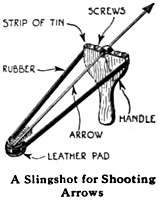 A 1922 diagram showing the construction of an arrow-firing slingshot
A 1922 diagram showing the construction of an arrow-firing slingshot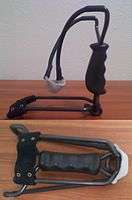 A folding, steel framed wrist brace slingshot using tubular bands. Marketed by the Riley Kitchen Air Rifle Company.
A folding, steel framed wrist brace slingshot using tubular bands. Marketed by the Riley Kitchen Air Rifle Company..jpg) Modern slingshot with ergonomic grip (center), arm support (left), stabiliser and sight (right)
Modern slingshot with ergonomic grip (center), arm support (left), stabiliser and sight (right) Helmeted combatant fires a slingshot during clashes on February 18, 2014, in Kiev, Ukraine
Helmeted combatant fires a slingshot during clashes on February 18, 2014, in Kiev, Ukraine
Record power shot
The world record for the most energetic shot with a handheld slingshot was 135 Joules (99.57 Foot-pounds). It was shot with a forward extended slingshot, also known as a "starship", which achieves more power by increasing draw length.[7]
Military use
Slingshots have been used as military weapons, but primarily by guerrilla forces due to the primitive resources and technology required to construct one. Such guerrilla groups included the Irish Republican Army; prior to the 2003 invasion of Iraq, Saddam Hussein released a propaganda video demonstrating slingshots as a possible insurgency weapon for use against invading forces.[8]
Slingshots have also been used by the military to launch unmanned aerial vehicles (UAVs). Two crew members form the fork, with an elastic cord stretched between them to provide power to launch the small aircraft.[9]
On the Battle of Marawi, the soldiers of the Philippine Army's elite Scout Rangers were observed using slingshots with grenades as an improvised mortar to eliminate the Maute and Abu Sayyaf Terrorists.[10]
Dangers
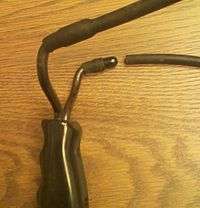
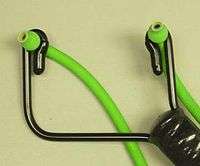
One of the dangers inherent in slingshots is the high probability that the bands will fail. Most bands are made from latex, which degrades with time and use, causing the bands to eventually fail under load.[3][12] Failures at the pouch end are safest, as they result in the band rebounding away from the user. Failures at the fork end, however, send the band back towards the shooter's face, which can cause eye and facial injuries.[13] One method to minimize the chance of a fork end failure is to utilize a tapered band, thinner at the pouch end, and thicker and stronger at the fork end.[14] Designs that use loose parts at the fork are the most dangerous, as they can result in those parts being propelled back towards the shooter's face, such as the ball attachment used in the recalled Daisy "Natural" line of slingshots (see image). The band could slip out of the slot in which it rested, and the hard ball in the tube resulted in cases of blindness and broken teeth. Daisy models using plain tubular bands were not covered in the recall, because the elastic tubing does not cause severe injuries upon failure.[13] Another big danger is the fork breakage, some commercial slingshots made from cheap zinc alloy may break and severely injure shooters' eyes & face. [15]
Legal issues
Many jurisdictions prohibit the use of arm-braced slingshots. For example, New York law 265.01 defines it as a Class-4 misdemeanor.[16]
In popular culture
The slingshot is heavily featured in the popular gaming franchise Angry Birds, used as the primary launching device for shooting birds at enemy pigs.[17]
Bart Simpson is often depicted using a slingshot to engage many pranks.
The slingshot is the signature weapon of protagonist Jimmy Hopkins in the video game Bully. A basic slingshot is available at the beginning of the game; a more advanced slingshot with ergonomic grip and "scope" can also be unlocked fairly early in the game.
Gallery
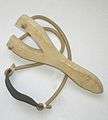 Simple slingshot using a wooden fork, tubular bands and a leather pouch.
Simple slingshot using a wooden fork, tubular bands and a leather pouch. Steel ball used as slingshot ammunition
Steel ball used as slingshot ammunition
References
- Wham-O Hunting Slingshot. Wham-O Manufacturing Co. 1963.
- "How to Make a Slingshot for an Arrow". Illustrated World. R. T. Miller Jr. 37 (1): 318. March 1922.
- Melchior Menzel. "Rubber Bands".
- Melchior Menzel. "The ZipZip".
- Tom Cushing (August 1946). "Rubber-Band Sharpshooter". Popular Science: 154–155.
- Robert Hertzberg (April 1951). "Return of the Giant Killer". Mechanix Illustrated.
- Monster Slingshot New World Record Shot https://www.youtube.com/watch?v=pAwTfAMHCG0
- Shane, Scott (2006-11-24). "In Video, Hussein Uses Slingshots and Bows to Rally Iraqis for War". The New York Times. Retrieved 2009-12-21.
- Tech. Sgt. Paul Dean (April 5, 2011). "Security Forces Unmanned Aerial Vehicles". Air Force News Service.
- https://www.update.ph/2017/09/look-scout-rangers-use-improvised-giant-slingshot-in-marawi-angry-birds-style/20991
- 18th Spanish national slingshot championship (in Spanish)
- Melchior Menzel. "Attaching the bands to the frame".
- U.S. Consumer Product Safety Commission. "Slingshots Recalled by Daisy Manufacturing Due to Risk of Serious Eye Injury" (PDF).
- Melchior Menzel. "Attaching the pouch to the bands".
- DANKUNG. "Danger of zinc alloy slingshots".
- "Penal100". nycourts.gov.
- "See The Smartphone That Can Bend, Not Break". Retrieved 2018-12-27.
| Wikimedia Commons has media related to slingshots. |
